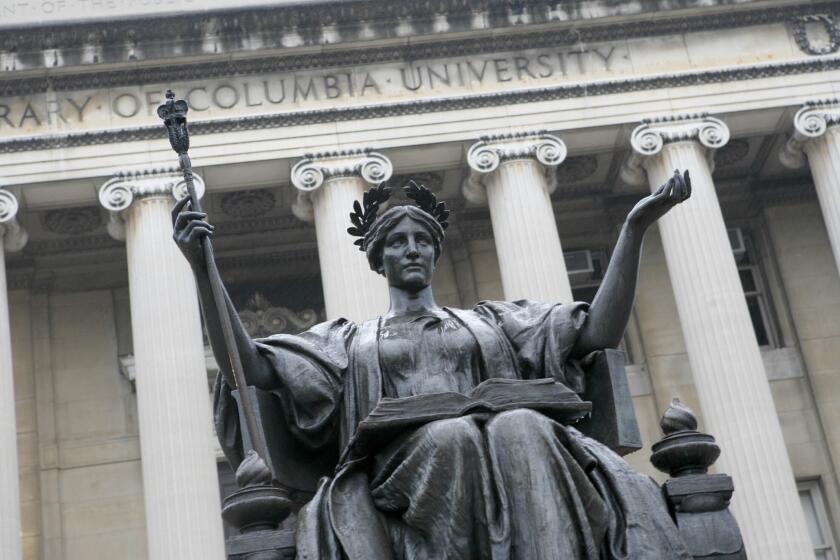Students, Schools Find Few Pluses to Applaud
Dazed and confused. That’s how many California public schools felt by the end of 2002 -- a difficult year despite some promising moments for the state’s 6 million schoolchildren.
Schools struggled to produce better academic results and obey a bevy of new rules from Washington even as they were forced to consider layoffs and other desperate measures because of the state’s gaping budget shortfall.
“We’re expected to do more with less,” lamented Dick Van Der Laan, spokesman for the Long Beach Unified School District.
Campuses were fascinated at times with such student life issues as backpack loads, junk food and cell phones and whether the Pledge of Allegiance should be recited in class. But those, as the new year approached, seemed minor compared with statewide money shortages and new federal rules.
School district leaders and state education officials scrambled to comply with the new No Child Left Behind education law that President Bush signed last January. That measure requires campuses serving low-income children to hire only “highly qualified” teachers and for students in failing schools to have the option of transferring to better campuses.
District superintendents around the state called the law unrealistic, given their shortages of qualified teachers, classroom space and other resources. But the Bush administration stood firm, insisting there would be no cause for denying transfers.
Even as state educators fretted over No Child Left Behind, they began discussing whether to delay enforcement of California’s new high school graduation exam because of poor passing rates. Fewer than half of the state’s current 11th-graders have passed both the English and math portions of the exam, state officials reported in October.
Still, California schools had cause to celebrate last year: Stanford 9 standardized test scores rose for the fourth straight year, albeit less than in previous years. And California voters reached generously into their pockets for public schools, approving about $22.4-billion worth of school construction bonds in November, the largest amount from a single election day in state history.
In Los Angeles Unified, voters handily approved a $3.3-billion school construction bond that, along with state funds, will help the overcrowded school system to build as many as 120 new campuses over the next 10 years.
The sweet taste of victory turned sour just a few weeks later when the district revealed that two of the six buildings at the half-finished Belmont Learning Complex sat over an earthquake fault. The district had revived Belmont earlier in the year after deciding that pollution problems, which had stalled the project, could be mitigated.
The seismic revelation, however, led district officials to once again halt plans to finish the school and further study what to do with the 35-acre property near downtown Los Angeles.
L.A. Unified also launched a promising remedial program for 35,000 middle school and high school students who read below a third-grade level. And the district, responding to scathing state audits of Fremont High School and nine other troubled schools, began replacing principals and teachers in an effort to restore order and boost morale.
In 2002, California’s largely unregulated charter schools came under more scrutiny, facing new financial and geographic restrictions.
For their part, California’s students regained the right to carry pagers and cell phones on campuses under a new law that reversed a long-standing ban on the devices, feared as tools of drug dealers.
And students even got a little help lightening their loads in an era when so many schools have banned lockers. The state passed a law requiring the state Board of Education to establish maximum weight standards for school textbooks.
A growing number of students can’t handle the extra weight. A December report by the California Center for Public Health Advocacy found that more than one-quarter of the state’s schoolchildren are overweight and nearly 40% are not physically fit -- most pronounced in Los Angeles County.
Schoolchildren also saw one of their classroom routines challenged when a federal appeals court found the Pledge of Allegiance unconstitutional.
The decision, stemming from a Northern California case, struck down a 1954 law that added the words “under God” to the pledge. The decision is on hold while appeals play out.
But state budget woes dominated the education agenda as the year drew to a close. Just weeks before the December school break, Gov. Gray Davis announced more than $3 billion in cuts to public schools and universities.
“It’s going to be very painful and tough,” said Los Angeles schools Supt. Roy Romer, whose district will have to cut about $140 million. The district already slashed more than $425 million in the current school year, partly by raising class sizes in grades 4 to 12.
Not even the popular state program to reduce classes to 20 students in kindergarten through third grade will be exempt, said Mark Skvarna, superintendent of the Baldwin Park Unified School District.
In response to the proposed budget cuts, the University of California and California State University systems approved their first systemwide student fee increases in eight years.
Officials warned that further fee increases, class reductions and faculty or staff layoffs may be necessary in the months to come.
The Los Angeles Community College District, already struggling with record enrollments and aging buildings, is expected to decide in January whether to move ahead with a new, multimillion-dollar bond measure.
Across the country, colleges were feeling a similar financial pinch, with dwindling state funds and shrinking endowments at a time of surging enrollments. In response, public colleges and universities increased tuition and fees an average of 10% during the year, the steepest rise in a decade, according to a survey by the College Board.
College scholarships increasingly were being awarded on the basis of achievement instead of financial hardship. That is likely to make it tougher for many students from poor and moderate-income families, educators said.
Back in California, the state’s public universities made news last year for other reasons: The Cal State system inaugurated its 23rd campus in August, opening the doors of Cal State Channel Islands to about 1,000 students on the grounds of a former state mental hospital near Camarillo. And the long-stalled UC campus near Merced in Central California got a boost late in the year when two separate courts denied requests by environmental groups to block construction.
In November, UC President Richard C. Atkinson, whose criticisms of the widely used SAT test led to major reforms in the college entrance exam last year, announced that he will step down from his post in October. The search for a replacement is sure to be one of the most closely watched appointments this year.
Atkinson, a cognitive psychologist whose tenure also included steering the university through tough debates over affirmative action, said:
“These have been extremely rewarding years, challenging, stimulating and deeply interesting years. But the time has come to bring them to a close.”
More to Read
Start your day right
Sign up for Essential California for news, features and recommendations from the L.A. Times and beyond in your inbox six days a week.
You may occasionally receive promotional content from the Los Angeles Times.






